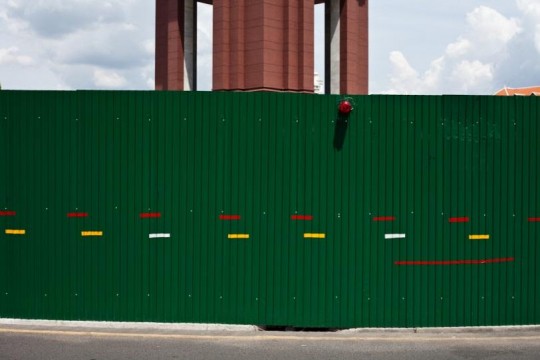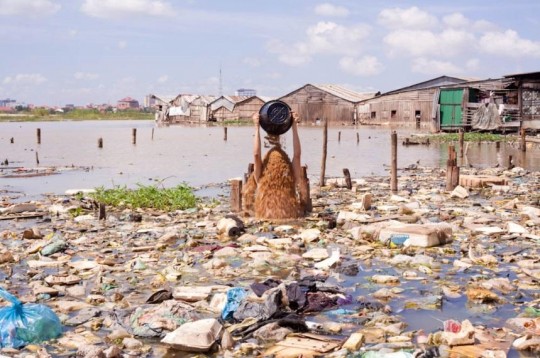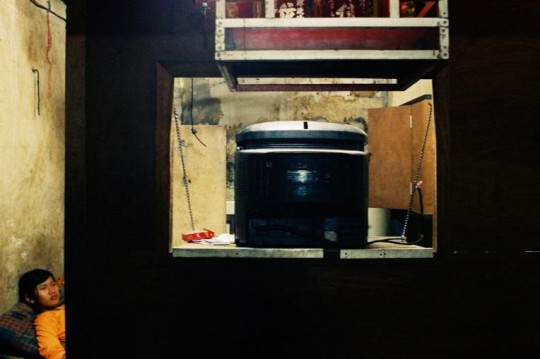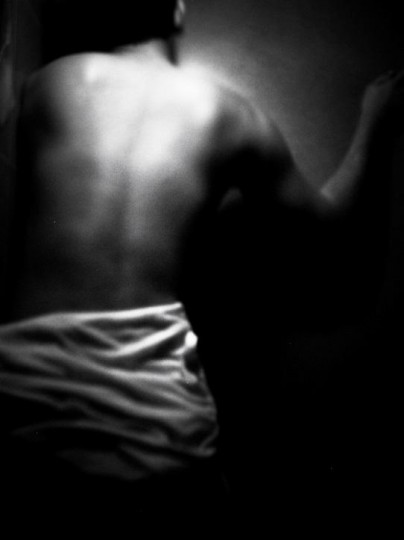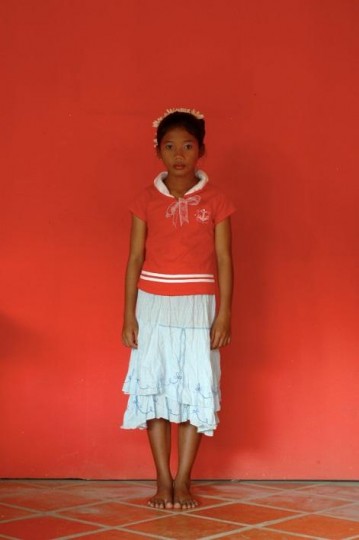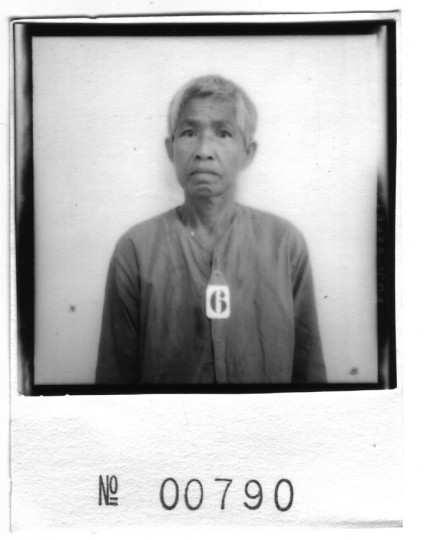by Zhuang Wubin
The years leading to the 1970 coup by Lon Nol that deposed Norodom Sihanouk, the American bombing from 1964 to 1975, the brutal reign of the Khmer Rouge (KR) from 1975 to 1979, and the subsequent Vietnamese rule until its military withdrawal in 1989 brought about massive upheavals in the lives of Cambodians.
Ironically, the dislocation also offers a convenient starting point for curators and art writers to begin the historiography of Cambodian photography.
In 2008, Cambodia heralded the first edition of PhotoPhnomPenh (PPP), a festival organized by the French Cultural Centre (CCF). The event was the brainchild of Christian Caujolle, founder of VU Photo Agency and one of the most esteemed photo curators in the French-speaking world.
In his curatorial text for PPP 2008, Caujolle notes that fifteen years ago, “photography was virtually absent from Phnom Penh, especially in its cultural and creative dimension… local production was limited to what is called applied photography, intended for the press or for postcards. It was at Tuol Sleng, with its unbearable portraits, that one saw Cambodian photography…”1
After highlighting the roles played by the CCF, the Bophana Audiovisual Resource Centre2 and the Angkor Photo Festival3 in promoting photography among young people, Caujolle notes that some of them have quickly moved beyond “photojournalism”. Today, contemporary photography exists in Cambodia.4
While there is some truth in his observation, the linearity of Caujolle’s narrative poses obvious problems. Inherent in his account is the assumption that “photojournalism” is inferior to contemporary photography, or that contemporary photography can only come at a more “advanced” stage, and that it is presumably some “higher” form of photography that only certain people can aspire.
Without offering a definition of contemporary photography in Cambodia, Caujolle’s account satisfies the usual “historiography” of photography in Southeast Asia—that the medium arrived from the West and took root with Euramerican help, flourishing subsequently across the region.
In the end, he cannot help but add that “the Arles festival ‘Rencontres Internationales de la Photographie’ will soon be 40 years old. As many years as Cambodia needs to catch up…”5
Of course, photographic technology did arrive from the West and that white photographers played a role in that transfer. However, the process whereby photography has been adopted and used in different parts of Southeast Asia proves to be a lot more complex than Caujolle’s account.
In Luang Prabang, for instance, old photographs owned by the Buddhist monasteries are taken to be “carriers of Karmic energies of those portrayed”. This is why, when abbots pass away, their photographic collections are traditionally distributed to his followers or cremated with their bodies.6 The process whereby photographic representation has become intertwined with Lao Buddhism merits further research.
Over in Java, in the decades that followed independence, Chinese studio photographers collaborated with Javanese backdrop painters from Sokaraja, Central Java, to satisfy their clients’ needs to be recognized, in their portraits, as “modern” citizens within a “national modernity realized in scenes of tropical landscapes, modern architecture, and iconic consumer commodities”.7
Before we dismiss these examples as concerns affecting only vernacular photography, it is worth recalling the message of art historian John Clark, “that cultural transfer is based on flows and needs constituted at the site to which the flow takes place. Under whatever conditions of constraint, Asian cultures had their own needs and developmental dynamics for the transfers they assimilated and transformed.”8
To Entertain or to Critique
In the 50s and 60s, the urban elite of Cambodia looked “both outside and inside the newly independent nation for available methods and materials” to “create forms that would be recognised as both Cambodian and modern”.9
At the School of Cambodian Arts, which would eventually become the Royal University of Fine Arts (RUFA) in 1965, students were already deliberating over the “negative” influence of photography on painting in the early 1950s. Much of the hostility against photography came from Japanese painter Suzuki who, by 1948, had set up an atelier for “new” or “modern” painting at the school. Many of his students like Sam Yuan and Sam Kem Chang would become the first “modern” painters of Cambodia.
Suzuki forbade his students from using photography as a source for their paintings. Instead, he emphasized the importance of direct observation.
Pen Tra (b. 1931; Kompong Cham), a student of Suzuki, recalls:
He [Suzuki] said it [photography] wasn’t true. It wasn’t “naturel”. He said that the photograph was like a mirror which absorbed everything. It pulled everything in so that you saw everything clearly… For him, even a really good photograph, people would look at it for a minute and then it was over. They wouldn’t look at it again.10
Nevertheless, many of his students would turn to photography, upon graduation, to aid their artistic practices.
From the mid 60s to the early 70s, the country also witnessed the heyday of Cambodian cinema.
Not surprisingly, some of the filmmakers dabbled in photography. As a student, even before he made his first films, Ly Bun Yim (b. 1942; Kompong Cham) was already taking photographs of the Kompong Cham landscape and selling them to foreign and Khmer tourists at his friend’s bookshop. He learnt how to develop film from a French manual and later on, figured out a way to make colour prints. He even “invented” an enlarger using a toilet bowl made from shiny porcelain.11
Ly’s inventiveness can also be seen in the poster of one of his most popular films in the 1960s, Au Euil Srey An (Khmers After Angkor).12 Photographic portraits of the film characters, some of whom in exaggerated expressions, are montaged onto the poster, creating a hypnotic and fantastical visual effect. It is as though the whole movie has been compressed into the poster without compromising the sense of anticipation that draws audiences to the theatres.
For both the filmmakers and painters at that time, they were faced with the same question of “whether the role of modern Cambodian art was to entertain or to critique society”.13
Today, there are quite a number of Cambodian photographers who are graduates from the painting department at RUFA, which reopened after the fall of the KR. In 1993, Thierry Diwo established a photo department at the university and Mak Remissa (b. 1970; Phnom Penh), originally enrolled as a painting undergrad in 1985, became one of his first students.
Khvay Samnang (b. 1982; Svay Rieng) and Heng Ravuth (b. 1985; Phnom Penh) also studied painting at RUFA. From September 2006 to June 2007, they learnt photography from Stéphane Janin at the now-defunct Le Popil Photo Gallery in Phnom Penh.
Initially, all three of them thought of picking up photography to learn an extra skill or to use it to help their painting practices. They now see photography as an artistic medium.14
For Cambodian photographers who produce independent work,15 there is a strong desire to tell stories from within, to reflect upon the histories, cultural norms and ways-of-life, which are being altered in this transforming country.16
In Wrapped Future (2009-10), Lim Sokchanlina (b. 1987; Prey Veng) photographs the boards and barricades that block off the numerous sites in Phnom Penh slated for “development”.
Our view of these sites is obscured. The nondescript nature of these barriers reveals and promises nothing. If anything, it serves as a metaphor for the future of the city, indeterminate and uncertain, where memories and histories exist—if we are lucky—only in photographs.
In Untitled (2011), Khvay Samnang responds to the privatization and filling-in with sand of the public lakes in Phnom Penh. From the perspective of the government and the developers, the idea is to turn these newly “created” land into commercial property. At Boeung Kak Lake, some 4,000 families have been evicted for this reason. This eviction is only dwarfed by the forced relocation of Phnom Penh residents to the countryside during the KR takeover in 1975. Apart from the obvious impact on the environment, the residents have also been inadequately compensated.
Shot at Boeung Kak and several other lakes, Khvay uses his body as a vessel of attrition, pouring sand over himself to mark the absurdity of this development. Despite the tightening of control in Cambodia, this is the first photo project that has adopted a critical stance on a specific issue in the last two decades. The danger of championing the cause is visualized in the physical danger of “performing” the work—waddling in murky water, cutting himself and attracting unwanted attention from the security.
Only in the photographic practice of Mak Remissa is there a conscious desire to entertain his viewers on a visual level.17 The striking use of colours in Water is Life (2009-10) serves to differentiate this work from the photographs that he produces as a fulltime photojournalist for European Pressphoto Agency. But he also hopes that the work will remind his audience of the importance of protecting our water resources for the future.
The Need to Record
In the turbulent years leading to the KR takeover, there were many Cambodian photographers who braved the danger and shot for news agencies around the world.
Some, like Dith Pran (1942-2008; b. Siem Reap), believed that his work would convince other countries to act in order to save his country from the impending tragedy.18 Others, like Ly Eng and Saing Hel, used text and photography to speak out against the corruption of the Lon Nol government, which enjoyed American military assistance. For their political views, they were nearly killed by the government.19
While the war in Vietnam received greater coverage in America, the conflict in Cambodia was a lot more dangerous to cover, partly because the American troops were not on the ground and that the photographers had to hit the roads where they would be vulnerable to the different factions at war. In fact, Western news agencies soon prohibited their photographers from going out into the field. Instead, they paid Cambodians very low rates to cover the conflict for them.20
Of course, in a country ravaged by war, working for a Western news organization meant a steady income.21 But the danger was real. This is the “first modern conflict where almost every journalist, photographer, television correspondent and cameraman to fall into the hands of the Khmer Rouge was killed”.22
Nevertheless, photographers like Thong Veasna and Tea Kim Heang felt compelled to persist. Their immediate and upfront portraits of children, photographed with weapons and seen with an expression of bewilderment, speak of the emotional toll of this convoluted conflict.23 Their desire to record is still shared by Vandy Rattana (b. 1980; Phnom Penh), although the urgency that he feels is different from that of the aforementioned photojournalists.
Due to the KR reign and the ensuing years of economic hardship, much of Cambodia’s audiovisual heritage since the 1950s had been lost or destroyed.24
According to Erin Gleeson, a specialist on Cambodian arts, most of the photographs made of Cambodia today revolve around “the two-T national allegory” of “temples and trauma”, clichés that leave much of the country un-photographed and unrepresented.25
One of the few female photographers in the country, Chan Moniroth Chiart (b. 1980; Phnom Penh) is a lot more blunt: “Foreign photographers usually focus on lady-boys and prostitutes whenever they do stories about Cambodia. These works are useless to Cambodians.”26
With Looking In (2005–06), Vandy counters these clichés by directing the viewfinder at his “mundane” environment. Ten years younger than Mak Remissa, he is the first Cambodian photographer in the last decade to situate his practice beyond aesthetic concerns or the day-to-day demands of press photography. Instead, it sits within a broader, existentialistic framework.
He explains:
What details make us “Cambodian”? I want to reveal the internal, to archive Cambodia as much as I can. It’s not for me. We have to tell the world who we are.27
Looking In features two stand-alone series, the first of which sees Vandy studying his family and the interiors of other Cambodian homes. In the second series, Vandy focuses on his colleagues at the Camintel Telecommunications Company where he worked for four years. The photographs create an archaeological collection of details, like his colleagues’ fashion sense or the office décor, which draws the project back to his starting framework.
Since then, due to his sense of mission in relation to Cambodian photography, Vandy has become the rallying point for the likes of Khvay Samnang, Heng Ravuth and Lim Sokchanlina, who emerged slightly later.
Cambodian Portraiture: From Picture Postcards to the S-21 Mug Shots
An early source of Cambodian photographic portraiture came via the picture postcard trade, which reached its peak in terms of production and popularity during the early 20th century. Presumably, French photographers or their agents were responsible for shooting most of the images on these postcards.28 The photographers were rarely identified, as the common practice was to print the name of the editor or publisher—and occasionally, that of the printer.29
Of course, it is naïve to expect these picture postcards to offer a “true” image of Cambodia. In the first place, photography has often been seen as the medium par excellence to represent “reality”, an unnecessary burden that has been exploited in different ways by politicians, artists, advertisers and photographers.
As mementos for sale, picture postcards are “merely illusions of a personal reality determined by the editor and photographer interested in marketing and making money from images at a certain time in history”.30 The decision to publish certain postcards was shaped by “ideological, commercial, jingoistic, and religious” considerations.31
Nevertheless, it is possible to make comments about the nature of photographic portraiture in Cambodia if we examine these postcards in detail.
It seems that the Cambodian royal family had enjoyed an easy relationship with the photographers of the colonial era. Popular with the French public, King Sisowath (r. 1904-1927) appeared in many of the postcards. Some of the postcards in the post-independence era even featured Sisowath and Norodom Sihanouk (r. 1941-1955 and 1993-2004) as cartoon characters.32
Compared to the monarchy, there were fewer colonial postcards of “ordinary” Cambodians. And there were fewer postcards of men than women. Men and boys were usually photographed in a straightforward and “manly” way. On the other hand, female nudity was rare,33 unlike in Java, where nude, “underage” girls appeared in quite a number of studio portraits in the early 20th century. These photographs were popular and sold for a lot of money in the west.34
In his artistic practice, Heng Ravuth uses the human body as his subject matter. In Nude Series (2010), he presents a series of naked self-portraits to counter the cultural norm of treating nudity with shamefulness in Cambodia. Heng finds beauty in his nudity, as he creates a mysterious and sensuous world in his “mundane” environment to perform for the camera, responding directly to his feelings at that instant.
In Cinderella (2006), Chan Moniroth Chiart presents a series of portraits of a girl who sells postcards to the tourists at Siem Reap. The “model” was first photographed in her usual clothes. She was then showered and dressed for the subsequent portraits. Revealing our tendency to judge based on appearances, the work, in a subtle way, deconstructs our “gaze”, which is partly responsible for casting these street kids as poor and useless.
Of course, in terms of photographic portraiture, the mug shots at the KR S-21 interrogation centre—known today as the Tuol Sleng Museum of Genocidal Crimes—loom constantly in our consciousness. It is impossible, even in Christian Caujolle’s brief account of Cambodian photography cited earlier, to ignore these portraits.35
Nearly a quarter of the population perished under the KR. With the exception of a handful of survivors, at least 14 thousand people were killed at the S-21. Taken immediately upon arrival, the production of these mug shots was part of an apparatus to intimidate the prisoners and to reinforce the regime’s “omnipotence and efficiency”.36
Sontag calls the experience of viewing these “anonymous” portraits as “sickening”, with the victims “forever looking at death, forever about to be murdered, forever wronged”.37
In fact, the S-21 mug shots have become the “undisciplined envoys of Cambodia’s traumatic past, circulating on a global scale and through various media”.38
As such, it is hard to avoid their imprint when we look at the equally anonymous photographs of Sovan Philong (b. 1985; Phnom Penh) in Computer Light Portraits (2010), even though the series has no connection with the KR whatsoever.
A student of Mak Remissa, Sovan illuminates his sitters with light from the computer screen. His sitters come from different parts of Cambodia. Some have no access to computer technology. Others use it for work or to connect with friends through Facebook. In these portraits, it is possible to imagine a kind of vague commentary about technology and society, although it is clear that Sovan is ultimately drawn by the “look” of his eerily lit subjects.
It is the work of Heng Sinith (b. 1964; Kandal), titled The Victims of History: Voices of the Khmer Rouge Victims and Perpetrators (2002), which contributes to our understanding of KR history. Heng and Mak Remissa were the first local photographers to work for the papers in the 90s. Their careers as photojournalists were literally thrust upon them, given the dearth of Cambodian photographers at that time.
Collaborating with researchers from the Documentation Center of Cambodia (DC-Cam), an NGO dedicated to the research of KR crimes, Heng tracks down mid- and lower-level cadres in order to photograph them, not to “show the history of their murders, but their lives as spouses and villagers”.39 These images are presented with the portraits of the cadres taken when they joined the revolution in the 70s.40
Researchers Meng-Try Ea and Sorya Sim explain:
The guards, interrogators and other staff at the infamous KR S-21 prison, are almost always depicted as heinous perpetrators of the Cambodian genocide. But it is rarely recalled that many, perhaps most, of these KR cadres were in fact children. They were deprived of their innocence and thrust into a world that none of them could have imagined, and few would have chosen.41
They “became slaves to a revolution they could not escape”, bearing “physical and “psychological scars from which they will never recover”.42 In fact, as many as one-third of the S-21 staff were also purged and killed.43
Heng’s work is not an attempt to normalize the cruelty of the KR. Instead, it warns us against the tendency to oversimplify its history.
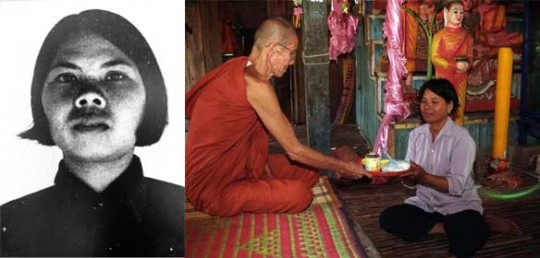
Heng Sinith, from the series The Victims of History: Voices of the Khmer Rouge Victims and Perpetrators, 2002, photography
In closing, by examining the photographies in Cambodia prior to the 1990s, this essay tempers with the linearity and narrowness of Caujolle’s account. The struggles and boundaries that the photographers in the past faced, the themes that they addressed, and the approaches that they adopted, continue to inform or constrain the independent photographers of the last decade. The years of turmoil did create a rupture. However, as we begin to piece together the historiography of photography from sources that have been “uncovered” in recent years, it is disheartening to find curators, cultural workers and writers who keep imagining that Cambodian photography emerged out of nowhere in the last decade—a mythology that is useful only to justify their “work” in the country or the kind of photography that they wish to “sell”.
Zhuang Wubin is a curator and researcher focusing on the photographic practices of Southeast Asia, and also a practicing photographer. A 2010 recipient of the research grant from Prince Claus Fund (Amsterdam), he is an editorial board member of Trans-Asia Photography Review, a journal published by the Hampshire College and the University of Michigan Scholarly Publication Office. His selected curatorial work includes the Southeast Asian section of Photoquai 2011, Musée du Quai Branly, Paris and Notes from the South: New Photography from Southeast Asia, at International Orange Photo Festival 2010, Changsha, China. His recent essays include ‘Out of Focus: Independent Photography in East Java,’ in Art Monthly Australia, October 2011; ‘Burmese Photography and the Issue of Control,’ in Asian Art, September 2011; and ‘Politics and Identity: Contemporary Photography in Thailand,’ in Trans-Asia Photography Review, 2011.
Zhuang Wubin also guest lectures in the MA Asian Art Histories Programme.
This essay was first published in a slightly different version on the Asian Art Archive website http://www.aaa.org.hk/Diaaalogue/Details/1144 and re-published with the kind permission of the author and Asian Art Archives.
All images courtesy of the author.
————————————————————————
- Les Éditions du Mékong and French Cultural Centre, PhotoPhnomPenh, exh. cat. (Phnom Penh: Les Éditions du Mékong and French Cultural Centre, 2008), 7. ↩
- See Zhuang Wubin, “The Bophana Audiovisual Resource Centre,” Asian Art, April 2007, 6-7, for a brief introduction of the centre’s aim of collecting the audiovisual heritage of Cambodia and the issues faced by its founder, Cambodian filmmaker Rithy Panh, in convincing senior photographers like Mak Remissa to come onboard and contribute to the archive. ↩
- Based in the tourist town of Siem Reap, Angkor Photo Festival preceded PhotoPhnomPenh (PPP). Founded by Christophe Loviny, Jean-Yves Navel and Gary Knight, the first edition took place towards the end of 2005. With the addition of PPP, Cambodia has become the only country in Southeast Asia (ASEAN) and South Asia to host two annual photography festivals. ↩
- Les Éditions du Mékong, PhotoPhnomPenh, 7. ↩
- Les Éditions du Mékong, PhotoPhnomPenh, 7. ↩
- British Library, “Archive of Buddhist Photographs in Luang Prabang, Laos,” Endangered Archives, http://www.bl.uk/about/policies/endangeredarch/2006/berger.html. ↩
- Karen Strassler, “Cosmopolitan Visions: Ethnic Chinese and the Photographic Imagining of Indonesia in the Late Colonial and Early Postcolonial Periods,” The Journal of Asian Studies 67, no. 2 (May 2008): 396-97. ↩
- John Clark, Modern Asian Art (Sydney: Craftsman House, 1998), 12. ↩
- Ly Daravuth and Ingrid Muan, Cultures of Independence: An Introduction to Cambodian Arts and Culture in the 1950’s and 1960’s (Phnom Penh: Reyum, 2001), vii. ↩
- Ly and Muan, Cultures of Independence, 283. ↩
- Ly and Muan, Cultures of Independence, 177-8. ↩
- See Ly and Muan, Cultures of Independence, 152, for a reproduction of the poster. ↩
- Ly and Muan, Cultures of Independence, 252-53. ↩
- Chan Vitharin (b. 1975; Phnom Penh), a classmate of Mak Remissa in Thierry Diwo’s class, adds: “When I first studied photography, I wanted to use it to help my painting. Now, I treat it as an artistic medium. People usually think that photography can only present the reality while you can do anything you want in painting. But who says photography cannot alter the reality? A lot of my ideas in photography are related to the history of painting.” For several years, Chan taught painting and the photography minor at RUFA. The minor has been canned since 2009 due to a lack of funding. See Zhuang Wubin, “Photography in the Post-Khmer Rouge Era,” Asian Art, June 2010, 8, for a brief introduction on Chan’s aestheticized—and sometimes abstract—photographic studies of façade and surfaces. ↩
- In my research, I have often used the phrase “independent photography” to bypass our lack of consensus in terms of defining what is photojournalism, documentary photography, art photography, conceptual photography and contemporary photography in Southeast Asia. Often, curators, artists and writers here rely on these labels to justify the “superiority” of a specific kind of photography that they wish to promote, without offering an adequate definition for these labels in the first place. The possibility that there is considerable overlap among the labels and that these labels may sometimes be used interchangeably to describe the same project seems to be an issue that has yet to be resolved. With the word “independent”, I emphasize the autonomy of the artists, a criterion that defines my research. I am interested in artists who pursue non-commissioned work. They do not start on a project for editors, collectors, galleries or curators. The “market” may come into the picture at the end, when the work is done, but not at the start. Of course, a commission may sometimes be an extension of the artist’s oeuvre. Therefore, it can still be classified as “independent photography”, provided that a comparison has been made with the artist’s oeuvre. See also T. K. Sabapathy, “In Conversation: Soraya Yusof Talismail & T. K. Sabapathy,” in Imaging Selfs: Portraits of Artists, ed. T. K. Sabapathy (Kuala Lumpur: Petronas Gallery, 2008), 50. ↩
- Here, I reference Erin Gleeson’s deliberate usage of the word “transforming”, instead of “developing”, to describe Cambodia today. Gleeson is an American specialist on Cambodian arts based in Phnom Penh for a decade now. She adds that “transforming is like changing the voltage on the development of a culture or way of life in a way that makes its appearance and character different—thus defining what is ‘happening’ to Cambodia this century due to myriad globalising movements”. See Erin Gleeson, “Mutualism for the Future,” in Who Cares? 16 Essays on Curating in Asia, ed. Alvaro Rodríguez Fominaya and Michael Lee (Hong Kong: Para/Site Art Space; Singapore: Studio Bibliothèque and Seed Projects, 2010), 71. ↩
- In his previous work, When the Water Rises, the Fish Eats the Ant; When the Water Recedes, the Ant Eats the Fish (2005), Mak Remissa uses macro photography to create visually stunning imageries in strong colours and unusual composition to express his anxieties about the politics of Cambodia. See Zhuang, “Photography in the Post-Khmer Rouge Era,” 8, for a short analysis of this work. ↩
- The most famous Cambodian photographer of that era, Dith Pran’s work as the fixer for American journalist Sydney Schanberg has been immortalized in the movie The Killing Fields. Perhaps the only photographer who worked for American media and survived the Khmer Rouge, Dith fled to America and in 1980, started shooting for New York Times. See Douglas Martin, “Dith Pran, Photojournalist and Survivor of the Killing Fields, Dies at 65,” New York Times, March 31, 2008, http:// www.nytimes.com/2008/03/31/nyregion/31dith.html?pagewanted=1. A slideshow of his work can be seen at http://www.nytimes.com/slideshow/2008/03/31/nyregion/20080331_DITH_10.html. ↩
- Horst Faas and Tim Page, ed., Requiem: By the Photographers Who Died in Vietnam and Indochina (New York: Random House, 1997), 315. ↩
- Jon Swain, “Sideshow—The War in Cambodia,” in Requiem: By the Photographers Who Died in Vietnam and Indochina, ed. Horst Faas and Tim Page (New York: Random House, 1997), 278. ↩
- Swain, “Sideshow,” 279. ↩
- Swain, “Sideshow,” 276. ↩
- Faas and Page, Requiem, 284-85. ↩
- Zhuang, “The Bophana Audiovisual Resource Centre,” 6. ↩
- Francesca Sonara, “After the Headlines Fade” (master’s thesis, Bard College, 2010), 26. ↩
- Chan Moniroth Chiart, interview by author, Phnom Penh, Cambodia, March 28, 2009. ↩
- Vandy Rattana, interview by author, Phnom Penh, Cambodia, December 2006. ↩
- Joel G. Montague, Picture Postcards of Cambodia 1900—1950 (Bangkok: White Lotus, 2010), 38. ↩
- Montague, Picture Postcards, 30. ↩
- Montague, Picture Postcards, 34. ↩
- Montague, Picture Postcards, 33. ↩
- Montague, Picture Postcards, 55. ↩
- Montague, Picture Postcards, 134. ↩
- Ineke Zweers, “Commercial Photography,” in Toekang Potret: 100 Years of Photography in the Dutch Indies 1839-1939 (Amsterdam: Fragment Uitgeverij; Rotterdam: Het Museum, 1989), 78-81. ↩
- When Christian Caujolle served as the artistic director of Les Rencontres photographiques d’Arles in 1997, he exhibited some of the S-21 mug shots during the event. It coincided with the news that the Museums of Modern Art in America acquired some of the portraits. Art theorist Thierry de Duve uses this as an extreme test case against the standard humanist legitimation of art and art institution. He also argues that Caujolle assumed the role of an artist, on behalf of the S-21 photographer, in his curatorial decisions, which were influenced by anti-aesthetic theories of art. See Thierry de Duve, “Art in the Face of Radical Evil,” October 125 (Summer 2008): 3-23. ↩
- Rachel Hughes, “The Abject Artefacts of Memory: Photographs from Cambodia’s Genocide,” Media, Culture & Society 25, no. 1 (2003): 25. ↩
- Susan Sontag, Regarding the Pain of Others (New York: Picador, 2004), 61. ↩
- Hughes, “Abject Artefacts of Memory,” 24. ↩
- Heng Sinith, The Photographer Sinith Heng: My Heart and Soul, Documentation Center of Cambodia, http://d.dccam.org/Archives/Protographs/Former_Khmer_Rouge/Sinith.htm. ↩
- See David Chandler, Voices from S-21: Terror and History in Pol Pot’s Secret Prison (New South Wales: Allen & Unwin, 2000), 27, who points out that the photographers who took the mug shots also made identification portraits of the S-21 staff. ↩
- Meng-Try Ea and Sorya Sim, “Victims and Perpetrators? The Testimony of Young Comrades at S-21,” in Night of the Khmer Rouge: Genocide and Justice in Cambodia, ed. Jorge Daniel Veneciano and Alexander Hinton (New Jersey: Paul Roberson Gallery, 2007), 26. ↩
- Ea and Sim, “Victims and Perpetrators?” 25. ↩
- Meng-Try Ea and Sorya Sim, Victims and Perpetrators?—Testimony of Young Khmer Rouge Comrades (Phnom Penh: Documentation Center of Cambodia, 2001), 46. ↩


